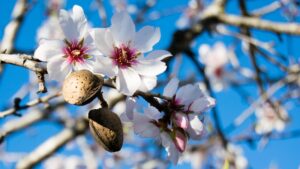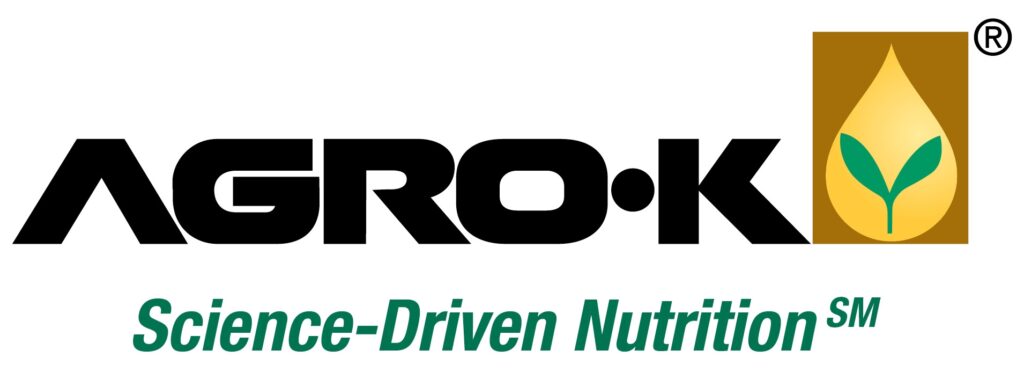Maximizing Almond Yield is Critical to Profitability in the Current Environment
Providing the right nutrients at bloom supports flower health, pollen viability, and improves fruit set.
Almond growers are facing a rarity — a cool, wet spring…and bloom-time fungicide applications.

Photo: olly_plu – stock.adobe.com
Due to the record-breaking drought across California the last few years, growers largely kept the sprayers out of the field during bloom because fungicides were not needed. Consequently, not spraying fungicides because disease pressures were low also meant that important foliar nutrients weren’t applied either. Nuts per acre, nut size, kernel weight, and yield potential are determined very early in the growing season, even tracking back to hull split the season before. The improvement of these yield components relies on the presence and availability of nutrients to the developing flowers and nutlets at time of demand. Yet soil temperatures during this period remain low, limiting nutrient solubility and microbial activity in the soil. When cold soils are coupled with low air temperature, the movement of these nutrients from the soil to the growing plant parts is almost zero. As a result, many almond trees will experience nutritional deficiencies during the critical nut, leaf, and vascular development windows of early spring, significantly reducing nut set, size, and yield.
“For the past few years, the weather has been dry and bloom-time disease pressures have been low. Without the need to apply fungicides, many growers made the decision to stay out of the field altogether. While the effects of bloom time diseases are usually very visible and if not addressed will dramatically reduce yields, the ‘hidden losses’ from nutrient deficiencies occur rain or shine and are difficult to see,” says Sean Jacobs, Technical Marketing Representative at Agro-K. “The flowers and developing nutlets have nutritional needs that, if not satisfied will limit yield by reducing pollination, fertilization, and nutlet cell division, setting the grower up for a poor year right out of the gate.”
Supporting Flower Development and Fruit Set is Critical in Wet or Dry Seasons
Considering the dry conditions of recent springs, it is essential to prepare a well-designed foliar nutrient program for growers who want to achieve maximum economic yields in 2023. In fact, well-designed nutrient programs are essential in both dry and wet years. Without moisture from rain, pollen and flowers desiccate rapidly. Both pollen and flowers need to stay fresh for fertilization to occur, and desiccation reduces pollen’s viability and rapidly shortens the bloom receptivity window. As the amount of viable pollen and receptive flowers decrease, so does nut set and subsequently yield. Providing foliar nutrition at pink bud and bloom timings ensures that the pollen and flowers have maximum viability, are better able to handle desiccation and temperature stresses, and results in optimum nut set.
Jacobs says it is easy to overlook the yield loss caused by flower drop, because it is common for almond trees to lose more than 70% of their flowers.
“Mature almond trees start out with 10,000 to 12,000 flowers each spring, and after pollination, fertilization, and successful fusion of sex cells, only about 2,000 to 3,000 endure to harvest as fully developed almonds,” he says. “Of these 7,000 to 9,000 flowers that fail to become nuts, roughly 20% were defective flowers, and 20% were killed by insect or disease or other damage that evaded chemical protection. This 40% loss is largely out of our control. The other 60% of flowers that failed, did so because they weren’t fertilized. In this 60%, theoretically all could have developed into viable nuts. Maybe some didn’t receive pollen at all, or the flower or pollen desiccated before pollination/fertilization occurred successfully, in others, nutritional demands weren’t satisfied at the time of need and fertilization failed. Flowers and pollen need boron for the pollen tube to develop, phosphorus to provide energy for cellular function, and enough calcium for cell wall assembly, structural integrity, and cell division. If proper nutrition is provided to the flowers and developing nutlets when they need it, 1 to 3% of our 7,000 to 9,000 lost flowers—or another 75 to 150 pounds per acre—can make it to harvest. When we see yield losses from brown rot or plant bugs, or damage penalties caused by navel orangeworm at the processor, we do something about it. Yet here we have a real opportunity to positively affect our yields and many fail to capitalize on it.”
The right nutrients applied during the pink bud and bloom timings can make all the difference. Cal Sea-Set, a sugar-complexed calcium foliar combined with boron, molybdenum, and seaweed is an excellent fit for pink bud and bloom time sprays. Cal Sea-Set is designed to maximize synergies between calcium and boron, and boron and molybdenum, improving set and maintaining cell division. Supplemental calcium signals for, supports, and is used in the production of new cells. Boron ensures successful pollen tube development and fertilization, and aids in sugar movement. Molybdenum, a key element in nitrogen metabolism, oxygen, sulfur, and potassium cycling, facilitates stress responses, and growth. And Agro-K’s seaweed product, Symspray®, is also in the bottle and further reduces the effects of environmental stress on the flowers when applied during pink bud and bloom, extending bloom receptivity and increasing pollen viability even when conditions are dry.
By adding AgroBest® 9-24-3 to the tank with Cal Sea-Set during cell division, calcium and phosphate work together in the plant to promote larger, heavier nuts. AgroBest 9-24-3 is a high phosphate/low potassium blend that delivers the phosphate energy the tree needs to maximize nut cell division, nut size, and nut retention. It is specifically designed with minimal potassium content so early-season foliar applications won’t antagonize calcium uptake and assimilation during nut and leaf cell division.
Phosphites Can Offer Benefits in Wet Conditions
During the post-petal fall/rapid leaf development stage, the use of a phosphite such as Sysstem®-LeafMax (0-20-0) is especially important, and even more so during a wet spring.
Jacobs says during the last few dry years, soil moisture outside of the irrigation zone was low, which means that opportunistic soil exploration and nutrient mining by new roots was minimal.
“Phosphites are an ideal delivery tool for nutrients — they are systemic in the tree and can deliver nutrients down to the roots,” Jacobs says. “They trigger root and shoot growth and can aid those new roots expanding out into the soil this year. Our Sysstem-LeafMax contains manganese and zinc in a systemic phosphite form, driving these nutrients to root and shoot growing points where they are essential for root and shoot health and development.”
Ultimately, neglecting foliar nutrient bloom applications will produce smaller, lighter nuts, and lower yields. Rain or shine, implementing a Science-Driven™ foliar nutrition program at bloom increases set, nut size, and drives yields higher, maximizing your profit margin.




